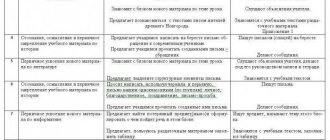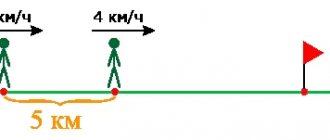Self-analysis of a mathematics lesson
Self-analysis of the lesson
mathematics in 1b grade
on this topic «
Numbers from 1 to 10. Number 0. Numbering
»
Program section
: "Numbers from 1 to 10. Number 0. Numbering"
Lesson topic
: Repetition and consolidation on the topic “Numbers from 1 to 10”
Lesson type
: consolidation of learned material
Target
: Contribute to the updating of knowledge and skills on the completed topic “Numbers from 1 to 10. Numbering”; promote the development of positive motivation for educational activities; promote the development of oral speech, the ability to express one’s point of view, listen to others
Learning objectives aimed at achieving personal learning outcomes:
show interest in mathematics; master the role of a student based on following the rules of behavior in the lesson, interaction with the teacher and students
Educational tasks aimed at achieving meta-subject results:
Regulatory:
learn to accept a learning task and maintain it throughout the lesson; carry out final control on the result under the guidance of the teacher, evaluate the correctness of the action;
Cognitive:
understand the simplest models; learn to build simple reasoning;
Communicative:
use simple speech means; engage in dialogue with the teacher and peers, in collective discussion; answer teacher's questions;
Educational tasks aimed at achieving subject-specific results:
learn to reproduce a sequence of numbers from 1 to 10 in both forward and reverse order; determine the place of each number in this sequence; write numbers from 1 to 10; relate number and number; compare any two numbers and write the result of the comparison using comparison signs =, > ,< ; recognize shapes: triangle, square, circle, rectangle;
Equipment for the lesson:
projector, laptop, cards for independent work, set of geometric shapes.
The lesson is structured in accordance with the Federal State Educational Standard, using information and communication technologies.
This lesson used an activity-based approach.
in teaching.
Any process of cognition begins with an impulse that encourages action. Motivation is needed to encourage the student to begin the activity. With this in mind, I carefully thought through each stage of the lesson, composed assignments, selected questions, and used various techniques to activate students. At the stage of updating knowledge
Students worked actively and formulated conclusions.
The content of the lesson included elements of teaching schoolchildren universal educational actions: the purpose of the lesson was determined by the students themselves, based on the relevant situation. Using a sign system, a learning task
recorded on the board.
At all stages of the lesson, the students were involved in active mental and practical activities of a research nature (counting on a ruler, working with geometric shapes); the children had to remember and use existing knowledge.
Primary consolidation
occurred when solving examples with commenting at the board (front work).
Work in pairs
and mutual assistance made it possible to reduce students’ anxiety; checking the results contributed to the formation of adequate self-esteem in children.
Incorporating new knowledge into the system
knowledge was organized in solving the problem. Self-testing the solution to the problem based on the example on the board allowed each child to feel successful.
Training exercises
were carried out independently, with mutual verification. The grades given (“+”, “-”) were justified.
When summing up and reflecting
self-analysis of students’ activities was used.
The stages of the lesson were closely interconnected, various types of activities alternated. Throughout the lesson, the educational material worked to organize a feasible search and corresponded to their life experience.
A situation of success was created for each student, which also helped to increase motivation and maintain cognitive interest in learning.
When asking questions and defining tasks in the lesson, I took into account the individual characteristics of the students, gave only positive characteristics to the results of their activities, which stimulated the children and increased their activity in the lesson.
The educational material of the lesson complied with the principles of science, accessibility and was suitable for first grade students. Educational information was clear and attractive to children. Due to the attractiveness of the content of the assignments and the presentation of educational material, the students’ opportunities to achieve their goals in the lesson increased.
Study time in the lesson was used effectively, the planned volume of the lesson was completed. The intensity of the lesson was optimal, taking into account the physical and psychological characteristics of first-graders.
During the lesson, rational use of time was observed; overload of children was prevented by quickly changing types of activities. Health-saving technologies (general impact exercise) were used. All proposed tasks are aimed specifically at the development of children. During the lesson, various forms of teaching were used: individual and frontal work, work in pairs. Children received individual assistance. During the lesson, a multimedia presentation was used, and all possible classroom resources were used. The lesson was very dynamic, conducted in a friendly working environment.
I believe that the lesson achieved its goals.
Future prospects:
- Continue to teach the children to work in pairs and in groups.
- Teach children to express their thoughts correctly.
- Get precise and correct answers from the kids.
Self-analysis of an algebra lesson in 9th grade
Math teacher self-analysis of algebra lesson
MAOU gymnasium No. 12 of the city of Tyumen Elena Vasilievna Beshentseva.
Lesson topic: “Systems of rational inequalities.”
Grade: 9.
This lesson took place as part of the algebra course in 9th grade.
The place and role of this lesson in the mathematics course were determined correctly, the lesson was in accordance with previous and subsequent lessons.
The main stage of the lesson was the stage of initial presentation of “new” knowledge. At the stage of the initial presentation of new knowledge, knowledge was updated and motivation to learn new things was carried out, a problem-based method was used: creating a problem situation, organizing a search for a solution to the problem, a dialogue leading to knowledge, and a method of comparing new knowledge with the scientific formulation of the textbook. I did not present the new knowledge in a ready-made form; the children were asked to formulate the topic of the lesson themselves and determine the goal to which they would strive.
The work organized in this way allowed students to navigate their knowledge system, distinguish what is new from what is already known with the help of the teacher, acquire new knowledge, find answers to questions using the textbook and information received in the lesson. Various forms of work were used: frontal, at the board with an explanation, in pairs. This contributed to the development of the ability to work in cooperation, to hear others and to speak in such a way as to be heard, to justify one’s answer, to take into account the opinion of a friend, to be able to argue and come to a common decision, to be able to express one’s opinion in a friendly manner, to listen to the opinion of a friend, as well as the development of logical thinking, mental abilities, imaginative thinking, speed of mental reactions. As a result of this work, students learned the information and also reproduced what they had learned in their memory. High performance in the lesson was ensured by a change in types of activities and the form of work organization.
Throughout the lesson, the interrelation of the assigned tasks was carried out through the organization of motivation at the beginning of the lesson, the creation of a plot of actions to update students’ knowledge, a smooth transition from one stage of the lesson to another, combining written work with oral work. The product of the lesson was a reminder on solving a system of inequalities with one variable.
During the lesson I used a multimedia presentation on the topic of the lesson. I used mathematical terminology and tried to ensure that the children used the same terminology when answering. The proposed tasks and forms of work in the lesson were both developmental and educational in nature. In terms of volume, the material was chosen correctly, as it fit within the time frame of the lesson, and the children did not experience great difficulties in completing it.
The chosen pace of educational work in the lesson allowed us to achieve the objectives.
Children independently solved systems, independently assessed the correctness of their solution, and answered at the board.
The use of problem-based learning in the lesson made it interesting, rich, and dense in structure.
When conducting the lesson, I used various types of control: student-student, self-control, student-teacher, comparing my work with the solution on the board.
I maintained the order and discipline of students in the lesson with the help of skillful organization, interesting material and a high degree of correctness. She constantly welcomed the children’s activity and encouraged independence. A friendly tone and the ability to control intra-collective relationships allowed all children to feel comfortable in the lesson.
The final stage was summing up and evaluating the results of the lesson.
High performance throughout the lesson was ensured by a change in types of activities, various forms of work organization (frontal, work in pairs, at the board, independent work with a textbook), as well as the use of health-saving technologies. This contributed to the creation of a positive psychological atmosphere and a situation of success in the lesson.
I believe that this lesson achieved all the goals set. In my opinion, the lesson was held at a high emotional level: both the students and the teacher enjoyed the communication.
Self-analysis of a mathematics lesson with the requirements of the Federal State Educational Standard
SELF-ANALYSIS OF THE LESSON
Chebykina M. R., primary school teacher
municipal budgetary educational institution
"Secondary school No. 42"
Nizhnevartovsk
We present to your attention a 1st grade mathematics lesson based on the educational and methodological complex “School of Russia”. The author of the textbook is M.I.Moro. Lesson topic Concepts “longer”, “shorter”, “equal in length”. Lesson type – lesson of discovering new knowledge. Lessons of this particular type give me the opportunity to most fully realize my pedagogical principle: “The goal of educating a child is to make him able to develop further without the help of a teacher.”
The planned volume of educational material, the degree of complexity of the information presented, and the method of its presentation were determined in accordance with the age characteristics of the students.
Based on this, in accordance with the requirements of the Federal State Educational Standard, I identified the following goals and set the objectives of the lesson.
Goals
:
Educational aspect:
clarify and form relationships “longer”, “shorter”, “equal in length”; develop the ability to compare the lengths of objects; strengthen counting skills within 4; develop the ability to see, compare, generalize and draw conclusions.
Developmental aspect:
develop computational skills, logical thinking, logical operations, mental operations of analysis, synthesis, comparison; promote the development of oral speech, the ability to express one’s point of view, and listen to others.
Educational aspect:
cultivate motivation for learning, the desire to learn and make discoveries and conclusions; instill responsibility for the performance of the work received and for one’s behavior, accuracy, and ability to make friends.
Form UUD:
Cognitive UUD:
navigate textbooks (notation system, text structure, headings, content); understand information presented in the form of text, pictures, diagrams; compare objects, objects: find commonalities and differences, group, classify objects, objects based on essential features, construct an oral speech statement according to given criteria; establish cause-and-effect relationships.
Regulatory UUD:
organize your workplace under the guidance of a teacher; exercise control in the form of comparing your work with a given standard; make the necessary additions and corrections to your work if it diverges from the standard (sample).
Communicative UUD:
observe the simplest norms of speech etiquette: say hello, say goodbye, thank you; engage in dialogue (answer questions, ask questions, clarify what is unclear); cooperate with comrades when performing tasks in pairs: establish and follow the order of actions, correctly report errors to a comrade; participate in a collective discussion of an educational problem.




